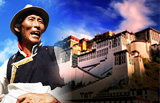Traditional Chinese medicine unleashes hidden potential
Updated: 2015-12-05 15:22
(Xinhua)
|
||||||||
BEIJING - Eighty-four-year-old Tu Youyou arrived in Sweden on Friday to collect China's first Nobel Prize in medicine for creating an anti-malarial drug that saved millions of people across the world.
Half a century ago, the pharmacologist derived artemisinin from sweet wormwood, which she found cited in a 4th century traditional Chinese medicine (TCM) text as an ingredient to cure fever, developing a crucial drug that has significantly reduced mortality rates for malaria patients.
The laureate is scheduled to deliver a speech in Stockholm, titled "Artemisinin is a gift that TCM has for the world."
Statistics show more than 240 million people in Sub-Sahara Africa have benefitted from artemisinin, and more than 1.5 million lives are estimated to have been saved thanks to the drug since 2000.
Apart from contribution to the global fight against malaria, TCM also played a vital role in the deadly Severe Acute Respiratory Syndrome (SARS) outbreak across China in 2003.
However, TCM, which is based on set of beliefs about human biology, including the existence of a life force, "qi", is seldom understood or embraced by the West. Some have even labeled it a "pseudoscience."
It is true it lacks a standardized guideline to administer treatments prescribed by practioners and therapists. But it is unfair to negate TCM as a whole, which is based on more than 2,000 years of practice in China.
Fortunately, the case is changing. After decades of scientific research, TCM has received wide recognition outside China and will offer more contributions to the world.
More and more people have accepted and tried TCM in Canada, Netherlands and Britain, thanks in part to frequent academic exchanges and effort by overseas Chinese.
In late June, the U.S. Food and Drug Administration (FDA) approved Kanglaite, an anticancer drug with active ingredients extracted from coix seed, for phase III clinical trials.
Kanglaite has been proven to have significant effects on middle or late-stage malignancies of pancreatic, lung and liver cancers. Once the phase III trial is passed, it could become the third medicine derived from TCM to enter the Western pharmacopeia following artemisinin, and ephedrine, a stimulant and decongestant derived from Mahuang.
With increasingly growing government funding and support, TCM is a booming industry in China, with a total value of 500 billion yuan (78.3 billion US dollars) in 2013, a third of the total output of the country's medical industry.
China published a five-year plan in May to promote TCM by increasing its role in the national healthcare system and making TCM products and services more competitive abroad. It also set the goal that each city and county should have at least one public TCM hospital.
There is no doubt that Tu's achievement will promote TCM globally, and that the heritage passed down from Chinese ancestors will bring more gifts to the world.
- Locals have tradition of drying foods during harvest season
- Beijing-Tianjin-Hebei govts to cooperate on emissions control
- Web promotion of prostitution to be targeted
- Two more spells of smog predicted to sweep North China
- Glass bridge in grand canyon of Zhangjiajie under construction
- Road rage cases pose huge safety challenge

 Can Chinese ‘white lightning’ make it in US?
Can Chinese ‘white lightning’ make it in US?
 Gunmen go on a killing spree in Southern California
Gunmen go on a killing spree in Southern California
 Chinese, South African presidents hold talks to cement partnership
Chinese, South African presidents hold talks to cement partnership
 China, Zimbabwe agree to boost cooperation
China, Zimbabwe agree to boost cooperation
 First lady visits Africa's 'new window' on China
First lady visits Africa's 'new window' on China
 BRICS media leaders to secure louder global voice
BRICS media leaders to secure louder global voice
 Western science in the eyes of Chinese emperors
Western science in the eyes of Chinese emperors
 Top 10 smartphone vendors with highest shipments in Q3 2015
Top 10 smartphone vendors with highest shipments in Q3 2015
Most Viewed
Editor's Picks

|

|

|

|

|

|
Today's Top News
Shooting rampage at US social services agency leaves 14 dead
Chinese bargain hunters are changing the retail game
Chinese president arrives in Turkey for G20 summit
Islamic State claims responsibility for Paris attacks
Obama, Netanyahu at White House seek to mend US-Israel ties
China, not Canada, is top US trade partner
Tu first Chinese to win Nobel Prize in Medicine
Huntsman says Sino-US relationship needs common goals
US Weekly

|

|








